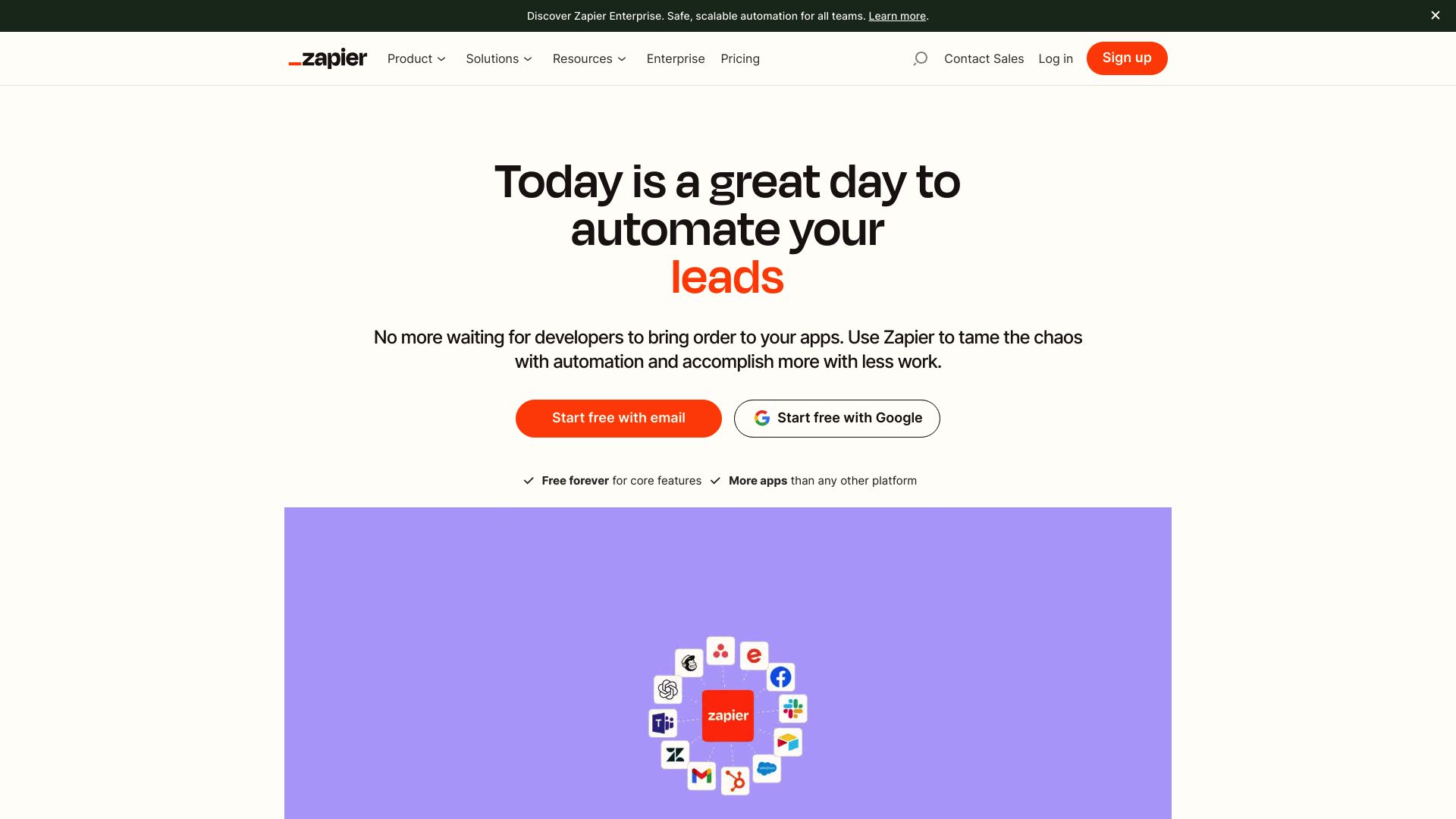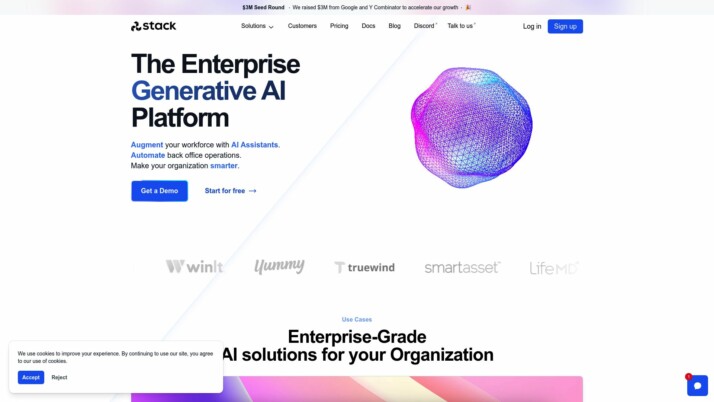Zapier vs. Stack AI: Comparing AI Automation Platforms
AI-powered automation transforms how businesses operate, streamline workflows, and boost productivity. This comparison explores Zapier vs. Stack AI, and SmythOS, three platforms at the forefront of this revolution. Zapier connects thousands of apps for seamless data flow, while Stack AI focuses on building custom AI assistants without coding. SmythOS takes AI integration further, offering advanced features like hosted agents and multi-agent collaboration.
Whether you’re a developer seeking powerful AI tools, a business leader looking to scale operations, or a non-technical user aiming to harness AI’s potential, this guide will help you navigate the strengths and limitations of each platform. Discover how these tools can elevate your workflow automation and AI integration strategies, empowering your organization to thrive in an AI-driven world.
Zapier Overview
Zapier empowers users to connect web applications and automate workflows without coding expertise. The platform’s extensive library of pre-built integrations enables seamless data flow between over 6,000 apps, streamlining business processes across organizations.


Zapier’s visual workflow builder, known as Zaps, allows users to create multi-step automations by defining triggers and actions. This no-code approach democratizes automation, enabling non-technical professionals to boost productivity and reduce manual tasks. For developers, Zapier offers a CLI and advanced API handling capabilities for custom integrations.
Zapier empowers users to connect web applications and automate workflows without coding expertise. The platform’s extensive library of pre-built integrations enables seamless data flow between over 6,000 apps…
The platform caters to businesses of all sizes, from solopreneurs to enterprise teams. Its scalable architecture supports high-volume automation needs while maintaining performance. Zapier’s focus on security, including OAuth support and robust logging, addresses concerns around data protection and compliance.
While Zapier excels in app integration and workflow automation, it lacks certain AI-centric features found in dedicated agent builders. The platform does not offer built-in natural language processing, conversational AI, or autonomous agent capabilities. However, its strength lies in connecting existing AI tools and services, allowing users to incorporate AI functionalities into their workflows through integrations.
Stack AI Overview
Stack AI empowers users to create AI-powered workflows and custom AI assistants without extensive coding expertise. The platform’s no-code interface features drag-and-drop functionality, making advanced AI capabilities accessible to a wide range of users.


Stack AI empowers users to create AI-powered workflows and custom AI assistants without extensive coding expertise.
Stack AI prioritizes enterprise-grade security, complying with SOC 2, HIPAA, and GDPR standards to ensure data protection and privacy. Users can deploy their AI applications through customizable interfaces or API endpoints, offering flexibility in implementation.
The platform boasts extensive integrations with popular services like Google Drive, Salesforce, Airtable, and Slack. This connectivity allows businesses to seamlessly incorporate AI into their existing workflows and systems.
Stack AI provides a library of pre-built templates for common use cases, accelerating development for specific needs. The platform’s high-touch customer success approach offers dedicated support from AI professionals, ensuring smooth implementation and operation of AI projects.
While Stack AI excels in accessibility and integration, it lacks some advanced features found in other platforms. The absence of hosted agents, autonomous agents, and multi-agent collaboration may limit its applicability for complex AI ecosystems. However, its focus on user-friendly design and enterprise security makes it an attractive option for businesses looking to quickly implement AI solutions without extensive technical resources.
Feature Comparison
Zapier and Stack AI offer distinct approaches to workflow automation and AI integration. Zapier excels in connecting disparate web applications, boasting over 6,000 pre-built integrations. Its visual workflow builder empowers non-technical users to create complex automations without coding. Stack AI focuses on AI-powered workflows and custom AI assistants, providing a no-code interface for building AI applications.
While both platforms offer visual builders and no-code options, they diverge in core AI capabilities. Stack AI provides built-in tools for creating AI assistants and chatbots, leveraging natural language processing. Zapier lacks native AI agent features but can integrate existing AI services into workflows. Stack AI’s enterprise-grade security compliance (SOC 2, HIPAA, GDPR) surpasses Zapier’s more generalized approach to data protection.
Zapier’s strength lies in its extensive app ecosystem and ease of connecting data between services. Stack AI offers more advanced AI-specific features like customizable AI deployments and dedicated AI professional support. However, neither platform matches SmythOS in areas like hosted agents, autonomous agents, or multi-agent collaboration, limiting their applicability for complex AI ecosystems.
Feature Comparison Table
| Zapier | Stack AI | SmythOS | |
|---|---|---|---|
| CORE FEATURES | |||
| AI Agents | ❌ | ✅ | ✅ |
| Hosted Agents (Dev, Production) | ❌ | ✅ | ✅ |
| Memory & Context | ❌ | ✅ | ✅ |
| Autonomous Agents | ❌ | ✅ | ✅ |
| Explainability & Transparency | ❌ | ✅ | ✅ |
| Multimodal | ❌ | ✅ | ✅ |
| Problem-Solving Capabilities | ❌ | ✅ | ✅ |
| Multi-Agent Collaboration | ❌ | ✅ | ✅ |
| Human-AI Interaction | ❌ | ✅ | ✅ |
| Agent Work Scheduler | ❌ | ✅ | ✅ |
| SECURITY | |||
| Constrained Alignment | ❌ | ❌ | ✅ |
| IP Control | ❌ | ❌ | ✅ |
| COMPONENTS | |||
| Foundation AIs | ❌ | ✅ | ✅ |
| Huggingface AIs | ❌ | ❌ | ✅ |
| Classifiers | ❌ | ✅ | ✅ |
| Logic | ❌ | ✅ | ✅ |
| Data Lakes | ❌ | ✅ | ✅ |
| DEPLOYMENT OPTIONS (EMBODIMENTS) | |||
| Deploy as Site Chat | ❌ | ✅ | ✅ |
| Deploy as Scheduled Agent | ❌ | ❌ | ✅ |
| Deploy as GPT | ❌ | ✅ | ✅ |
| DATA LAKE SUPPORT | |||
| Hosted Vector Database | ❌ | ✅ | ✅ |
| Sitemap Crawler | ❌ | ❌ | ✅ |
| YouTube Transcript Crawler | ❌ | ❌ | ✅ |
| URL Crawler | ❌ | ✅ | ✅ |
| PDF Support | ❌ | ✅ | ✅ |
| Word File Support | ❌ | ✅ | ✅ |
| TXT File Support | ❌ | ✅ | ✅ |
Best Alternative to Zapier and Stack AI
SmythOS stands out as the superior alternative to Zapier and Stack AI for agentic AI automation. Our platform combines the best of both worlds, offering extensive integration capabilities and advanced AI features in a user-friendly package.
Unlike Zapier’s focus on connecting web applications, SmythOS provides a comprehensive ecosystem for building, deploying, and managing AI agents. We go beyond simple workflow automation, enabling users to create intelligent, autonomous agents that can handle complex tasks across various domains.
SmythOS provides a comprehensive ecosystem for building, deploying, and managing AI agents… enabling users to create intelligent, autonomous agents that can handle complex tasks across various domains.
While Stack AI offers AI-powered workflows, SmythOS takes it further with our robust multi-agent collaboration features. Our platform allows teams of AI agents to work together seamlessly, tackling intricate problems that would be challenging for single agents. This capability opens up new possibilities for businesses looking to automate sophisticated processes.
SmythOS excels in ease of use, offering a visual drag-and-drop interface that makes agent creation accessible to users of all skill levels. Our extensive library of pre-built components and templates accelerates development, allowing users to quickly deploy AI solutions without extensive coding knowledge. At the same time, we provide the flexibility and customization options that advanced users need to create highly specialized agents.
With SmythOS, the possibilities are truly unlimited. Our platform supports a wide range of use cases, from customer service chatbots and content generation to complex data analysis and decision-making systems. By choosing SmythOS, businesses gain a powerful toolset that can adapt to their evolving needs, driving innovation and efficiency across their operations.
Conclusion
Zapier, Stack AI, and SmythOS each offer unique approaches to workflow automation and AI integration. Zapier excels in connecting web applications, boasting over 6,000 pre-built integrations and a user-friendly visual workflow builder. Stack AI focuses on AI-powered workflows and custom assistants, providing enterprise-grade security and dedicated AI professional support. While both platforms offer valuable solutions for specific use cases, SmythOS emerges as the superior choice for comprehensive AI agent development and deployment.
SmythOS stands out with its extensive feature set, including hosted agents, multi-agent collaboration, and advanced AI capabilities like natural language processing and problem-solving. The platform’s “Create Once, Deploy Anywhere” approach allows users to build versatile AI agents that can be seamlessly integrated across various environments. With support for over 300,000 integrations, SmythOS offers unparalleled flexibility in orchestrating complex workflows.
For businesses and developers seeking to harness the full potential of AI, SmythOS provides the tools to create sophisticated, autonomous agents that can handle a wide range of tasks. Its drag-and-drop interface, coupled with powerful features like multi-modal support and constrained alignment, makes it accessible to both technical and non-technical users. Explore cutting-edge AI templates to jumpstart your projects and see how SmythOS can transform your workflow.
Get started with SmythOS today to experience the future of AI automation. With a risk-free trial offering unlimited agents and a 30-day money-back guarantee, you can dive into AI-powered productivity without commitment. Unleash the power of AI for your business and join the revolution in workforce automation with SmythOS.
Last updated:
Disclaimer: The information presented in this article is for general informational purposes only and is provided as is. While we strive to keep the content up-to-date and accurate, we make no representations or warranties of any kind, express or implied, about the completeness, accuracy, reliability, suitability, or availability of the information contained in this article.
Any reliance you place on such information is strictly at your own risk. We reserve the right to make additions, deletions, or modifications to the contents of this article at any time without prior notice.
In no event will we be liable for any loss or damage including without limitation, indirect or consequential loss or damage, or any loss or damage whatsoever arising from loss of data, profits, or any other loss not specified herein arising out of, or in connection with, the use of this article.
Despite our best efforts, this article may contain oversights, errors, or omissions. If you notice any inaccuracies or have concerns about the content, please report them through our content feedback form. Your input helps us maintain the quality and reliability of our information.
